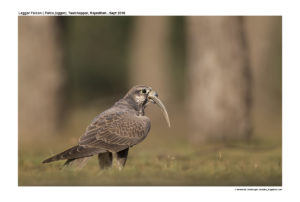Laggar-falcon

Laggar Falcon Falco jugger
Etymology:
- Falco : Latin for Falcon based on Sickle shaped claws ( falcis- sickle)
- Jugger : Hindi name Jaggar for the male Laggar Falcon
Vernacular Names : Hindi: Kohi, Jaggar, Mar: Laggad Sasaana
Distribution in India: Widespread resident in India except southern states of Kerala and Tamilnadu, East and North East of India.
Description: Size of 43-46 cm. It’s a large falcon. Adult has rufous crown, dark stripes to eye extending to nape, narrow but prominent moustachial stripes, brownish-grey to dark brown upper parts and uniform upper tail. Underwing coverts and underparts vary from largely white to heavily streaked. Lower flanks and thighs are dark brown. Shows a dark panel across underwing –coverts. Both sexes look similar but the female is larger and heavier than the male. Juvenile similar to adult but the crown is duller, moustachial stripe is broader and underparts heavily streaked. It’s entirely dark on belly, flanks and underwings and has a greyish bare parts.
Habitat: It is found in Arid to semi-arid open country, including dry woodland, cultivated areas, villages, and even cities; often seen perched on power poles and buildings.
Food Habits:It eats birds, including doves and gamebirds, but principally passerines; also wide variety of small mammals, including bats; reptiles, particularly lizards; and large insects, especially grasshoppers and beetles; will take domestic fowl on occasions. Hunts from exposed perch, launching swift, low-level attack flight when prey sighted. Occasionally hovers briefly, if prey goes undercover. Prey captured either in the air or on ground.
Breeding Habits: They breed from Feb-May in India. They nest in variety of sites. The nest is old stick nests of other birds, especially corvids and other raptors, without adding any material; in trees often near humans, on buildings, spires, towers, or even castles; on cliffs or rocky outcrops, sometimes on bare ledges; even in holes in earth banks. Spectacular display flights include mutual soaring, rapid pursuit of female by male, and male diving on female. It lays a clutch of 3–4 eggs. Both sexes incubate. The chicks are hatched altricial. Both parents hunt, female only when chicks older; female alone feeds chicks.